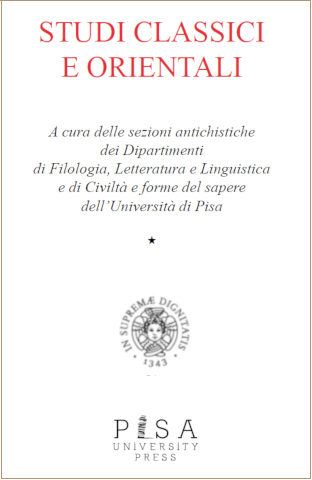IL PAPIRO DI DERVENI E LE TEOGONIE ORFICHE
Abstract
Speaking about the orphic theo-cosmogonic account involves referring to a range of different testimonies and fragments which are often difficult to arrange in a coherent system.The Derveni Papyrus shows a new connection between the later (V-IV century B.C.) and earlier orphic tradition (first half of II century A.D.): tough some mythems are specific to the recent orphic account and replace the ancient myths or the ancient divinities, the ancient myths and divinities do not disappear completely, but rather leave some visibletraces in the earlier accounts. These traces would be better interpreted as a replacement of the orphic mythical account, in the light of non-Greek traditions, rather than as evidence of a unitary tradition.
In other words, we should not postulate the existence of an orphic archetypal nucleus, as it would already have taken place such gods as Chronos or Protogonos/Phanes.
Furthermore, it can be demonstrated that there are no such traces of divinities in the Derveni Papyrus. Though the figures of Chronos (as primordial divinity) and Protogonos (as demiurgic divinity) represent a clear discrimen between the earlier and the later orphic
theogonies (dated no in the imperial age), I will rather try to demonstrate that one can trace a direct line of transmission between the Derveny Papyrus and the Rhapsodies.
My research suggests that the Derveni Theogony is the only
source of the Rhapsodies that is traceable among the remaining testimonies.
Two facts would confirm my hypothesis: 1) some fragments
belonging to the Rhapsodies show close verbal similarities
with the quotations from the Theogony in the Derveni Papyrus (showing that the compiler of the Rhapsodies would have known this ancient tradition). 2) In the Rhapsodies Phanes has exactly the same function of the Uranus' phallus in the Derveni Papyrus:
Phanes has in his belly the whole creation in exactly the same way as the penis contains all of the generative seeds. This is why Zeus, through the act of swallowing it, can re-create the reality.
This similarity of rank and role between Phanes and Uranus'
phallus opens up a new hypothesis. The earlier orphic tradition did not recognize the feature of Phanes as demiurge god: Zeus, creator of a new order of things, swallows his grandfather's penis in order to provide a definitive arrangement of the world. At a certain time,
however, the initiates of the orphic religion could have been embarrassed by the idea that a god swallowed the genitals of his progenitor.
This deed is considered an iniquity; Diogenes Laertius himself thought of it as such. Hence, the mystai felt compelled to replace the image of the phallus with another divinity, whose demiurgic role showed parallels with some divinities from the Near East. Obviously,
this ‘replacement' must not have prevented the earlier version from circulating even in recent times as Diogenes Laertius was able to recall it.
In brief, I will try to show that the role of Phanes in later orphism does not attest a completely separate tradition with respect to the earlier one, as testified by the Derveni Papyrus, but rather a conscious censorship put into effects by the initiates for ethical reasons.
[cferella@gmail.com]
Pubblicato
2011-02-07
Fascicolo
Sezione
Articoli


